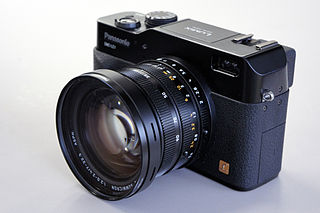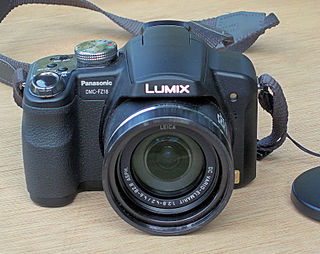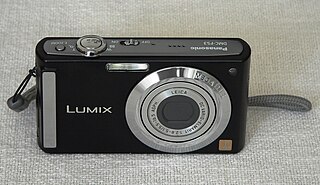Related Research Articles

Panasonic Lumix DMC-FZ20 is a 2004 superzoom bridge digital camera by Panasonic. It is the successor of the FZ10. The highest-resolution pictures it records are 2,560 by 1,920 pixels. It has a polycrystalline, thin-film transistor, liquid crystal display and EVF. It records to Secure Digital media. The camera also has a microphone. The camera's dimensions are 127.6 mm (5.02 inches) in width, 87.2 mm (3.43 inches) in height, and 106.2 mm (4.18 inches) in depth. Its mass is 520 g.
The Leica Digilux 1 is a digital camera developed in partnership with Panasonic, which was released in 2002, roughly the same time as the Canon PowerShot G2 and the Nikon 2000. It is the second of Leica's digital offerings. Where the original Digilux was developed in partnership with Fuji Camera, the Digilux 1 was developed jointly with Panasonic; Leica is responsible for optics, while Panasonic designs the camera electronics. According to Leica, this allows both companies to design cameras that creates a harmonious matching of lens to sensor to produce color and contrast to Leica standards.

Panasonic Lumix DMC-FZ30 is a bridge digital camera by Panasonic. It is the successor of the Panasonic Lumix DMC-FZ20. The highest-resolution pictures it records is 8 megapixels.

Lumix is Panasonic's brand of digital cameras, ranging from pocket point-and-shoot models to digital SLRs.

Bridge cameras are cameras that fill the niche between relatively simple point-and-shoot cameras and interchangeable-lens cameras such as mirrorless cameras and single-lens reflex cameras (SLRs). They are often comparable in size and weight to the smallest digital SLRs (DSLR), but lack interchangeable lenses, and almost all digital bridge cameras lack an optical viewfinder system. The phrase "bridge camera" has been in use at least since the 1980s, and continues to be used with digital cameras. The term was originally used to refer to film cameras which "bridged the gap" between point-and-shoot cameras and SLRs.

The Lumix DMC-L1 is Panasonic's first DSLR camera, and was announced in February 2006. This camera adheres to the Four Thirds System lens mount standard, making it the first non-Olympus Four Thirds camera, and thus confirming that the Four Thirds System is a semi-open standard such that compatible camera bodies can be built by different companies.

Panasonic Lumix DMC-FZ50 is a superzoom bridge digital camera by Panasonic.

The Panasonic Lumix DMC-FZ8 is a 7 megapixel superzoom bridge digital camera made by Panasonic. As with most Panasonic Lumix cameras, it uses a Venus Engine, in this case, the Venus Engine III. It supports the Raw image format and has the same sensor size and zoom level as its predecessor, the Panasonic Lumix DMC-FZ7.

The Lumix DMC-L10 is Panasonic's second digital single-lens reflex camera (DSLR), a follow-up to the previous Lumix DMC-L1 model. It was announced in August 2007, and, like the Lumix DMC-L1, this model uses the Four Thirds System lens mount standard and contains some basic parts provided by Olympus.

The Micro Four Thirds system is a standard released by Olympus and Panasonic in 2008, for the design and development of mirrorless interchangeable lens digital cameras, camcorders and lenses. Camera bodies are available from Blackmagic, DJI, JVC, Kodak, Olympus, Panasonic, Sharp, and Xiaomi. MFT lenses are produced by Cosina Voigtländer, DJI, Kowa, Kodak, Mitakon, Olympus, Panasonic, Samyang, Sharp, Sigma, SLR Magic, Tamron, Tokina, TTArtisan, Veydra, Xiaomi, Laowa, Yongnuo, Zonlai, Lensbaby, Kowa, Venus Optics and 7artisans amongst others.

The Panasonic Lumix DMC-FZ18 is a superzoom bridge digital camera that features:

The Panasonic Lumix DMC-G1 was the first digital mirrorless interchangeable-lens camera (MILC) adhering to the Micro Four Thirds system design standard. The G1 camera is similar to the larger Four Thirds system format DSLR cameras, but replaces the complex optical path needed for the optical viewfinder with an electronic viewfinder EVF displaying a live view image directly from the sensor. Eliminating the mirror box and optical viewfinder allows for smaller and lighter camera bodies, while the less complex optical path also allows for smaller, lighter lens designs.

The Panasonic Lumix DMC-GH1 is a digital mirrorless interchangeable lens camera adhering to the Olympus and Panasonic developed Micro Four Thirds System (MFT) system design standard. Panasonic classified the GH1 as a hybrid stills/video camera and the GH1 was introduced and marketed as a higher end camera than Panasonic's first MFT camera, the stills only, non-video capable Lumix DMC-G1.

The Panasonic Lumix DMC-GH2 is a digital camera with HD video recording capability that is part of the Micro Four Thirds system. Though commonly referred to as a DSLR camera, it has no mirror or optical viewfinder, but has instead both a fold-out LCD screen and a electronic viewfinder.

The Panasonic Lumix DMC-G2 is a digital mirrorless interchangeable lens camera adhering to the Olympus and Panasonic developed Micro Four Thirds System (MFT) system design standard. It was announced in March 2010 along with a lesser featured Panasonic Lumix DMC-G10.

The Panasonic Lumix DMC-FZ1000 is a digital superzoom bridge camera by Panasonic. It went on sale in June 2014. It has a 20 megapixel 3:2 BSI-CMOS sensor and Leica-branded 25–400 mm equivalent focal length lens with a maximum aperture of f/2.8 to f/4. It has a 1-inch CMOS sensor and supports ISO film speeds from 80 to 25600, shutter speeds from 1/16000 s to 60 s and RAW capture, while the lowest physical shutter speed is 1/4000 s. The unit is equipped with five "Fn" function buttons which can be allocated to custom shortcuts.

The Panasonic Lumix DMC-FZ5 is a superzoom bridge digital camera. It has Universal Serial Bus connectivity and has a mass of 326 grams (11.5 oz). It is featured with a black or silver model and was released by Panasonic in February 2005.
The Panasonic Lumix DMC-FZ1 is a compact digital camera announced by Panasonic on September 29, 2002.

The Panasonic Lumix DMC-FS3 is a digital ultracompact camera announced by Panasonic on January 29, 2008. It has eight megapixels, triple optical zoom, 16:9 wide VGA video recording at 30 frames per second, versatile scene modes, and an accelerometer sensor for orientation tagging.
The Panasonic Lumix DMC-FZ2500 is a 1" sensor DSLR-styled digital bridge camera released by Panasonic on November 28, 2016. It succeeded the Panasonic Lumix DMC-FZ1000, however the FZ1000 II was released in March, 2019 also. Its main competing model is the Sony RX10 III.
References
- ↑ Sullivan, Terry (April 19, 2006). "Panasonic Lumix DMC-FZ7". PC Magazine. Retrieved February 26, 2008.
- ↑ "Panasonic LUMIX DMC-FZ7 Wins DIWA Gold". Pixel Perfect Digital. November 17, 2006. Archived from the original on February 2, 2007. Retrieved February 28, 2008.
- ↑ "Panasonic Lumix DMC-FZ7 Review". dpreview.com. Retrieved May 16, 2016.